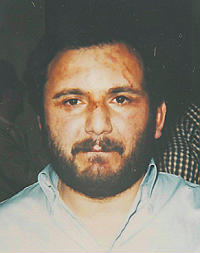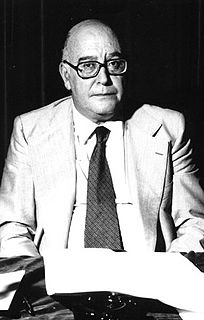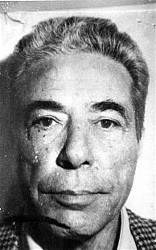
Giovanni Falcone was an Italian judge and prosecuting magistrate. From his office in the Palace of Justice in Palermo, Sicily, he spent most of his professional life trying to overthrow the power of the Sicilian Mafia. After a long and distinguished career, culminating in the Maxi Trial in 1986–1987, on 23 May 1992, Falcone was assassinated by the Corleonesi Mafia in the Capaci bombing, on the A29 motorway near the town of Capaci.

Giovanni Brusca is an Italian mobster and former member of the Corleonesi clan of the Sicilian Mafia. He had a major role in the 1992 murders of Antimafia Commission prosecutor Giovanni Falcone and businessman Ignazio Salvo, and once stated that he had committed between 100 and 200 murders. Brusca had been sentenced to life imprisonment in absentia for Mafia association and multiple murder. He was captured in 1996, turned pentito, and his sentence reduced to 26 years in prison. In 2021, Brusca was released from prison.

Salvatore Achille Ettore Lima was an Italian politician from Sicily who was associated with, and murdered by, the Sicilian Mafia. He is often just referred to as Salvo Lima.

Cinisi is a town and a comune in the Metropolitan City of Palermo in Sicily. As of 1 January 2018 it has a population of 12,250.

The Sicilian Mafia Commission, known as Commissione or Cupola, is a body of leading Sicilian Mafia members to decide on important questions concerning the actions of, and settling disputes within the Sicilian Mafia or Cosa Nostra. It is composed of representatives of a mandamento that are called capo mandamento or rappresentante. The Commission is not a central government of the Mafia, but a representative mechanism for consultation of independent Mafia families who decide by consensus. "Contrary to the wide-spread image presented by the media, these superordinate bodies of coordination cannot be compared with the executive boards of major legal firms. Their power is intentionally limited [and] it would be entirely wrong to see in the Cosa Nostra a centrally managed, internationally active Mafia holding company," according to criminologist Letizia Paoli.

Belmonte Mezzagno is a comune (municipality) in the Metropolitan City of Palermo in the Italian region Sicily, located about 15 kilometres (9 mi) south of Palermo.

Antonio Salamone was a member of the Sicilian Mafia and a member of the first Sicilian Mafia Commission. His nickname was “il furbo” – the shrewd one.

The Corleonesi Mafia clan was a faction within the Corleone family of the Sicilian Mafia, formed in the 1970s. Notable leaders included Luciano Leggio, Salvatore Riina, Leoluca Bagarella and Bernardo Provenzano.

Domenico "Mimmo" Raccuglia, nicknamed 'u vitirinariu, is a member of the Mafia in Sicily. He was a fugitive and included on Italy's most wanted list since 1996, until his capture on November 15, 2009, near Trapani.

Giuseppe Farinella was a Sicilian mafioso, boss of the San Mauro Castelverde family and a one-time member of the Sicilian Mafia Commission.

Ietas, was an ancient town of the interior of Sicily, in the northwest of the island, not very far from Panormus, in the modern comune of San Giuseppe Jato, whose name reflects the ancient town's.

The Greco Mafia family is historically one of the most influential Mafia clans in Sicily and Calabria, from the late 19th century. The extended family ruled both in Ciaculli and Croceverde Giardini, two south-eastern outskirts of Palermo in the citrus growing area and also rural areas of Calabria where they controlled the olive oil market. Members of the family were important figures in the Sicilian Cosa Nostra and Calabrian 'Ndrangheta. Salvatore "Ciaschiteddu" Greco was the first ‘secretary’ of the Sicilian Mafia Commission, while Michele Greco, also known as The Pope, was one of his successors.
Santino Di Matteo, also known as Mezzanasca, is an Italian former member of the Sicilian Mafia from the town of Altofonte in the province of Palermo, Sicily, Italy.
Gioacchino La Barbera is a member of the Mafia who became a pentito. He was one of the key witnesses in the trial against the killers of Antimafia judge Giovanni Falcone.
Baldassare Di Maggio, also known as Balduccio, is a member of the Mafia, who became a government witness (pentito). He helped the police to capture the head of Cosa Nostra, Totò Riina, and claimed that Riina respectfully kissed three-time Prime Minister Giulio Andreotti when they met in 1987.

Salvatore Riina, called Totò 'u Curtu, was an Italian mobster and chief of the Sicilian Mafia, known for a ruthless murder campaign that reached a peak in the early 1990s with the assassinations of Antimafia Commission prosecutors Giovanni Falcone and Paolo Borsellino, resulting in widespread public outcry and a major crackdown by the authorities. He was also known by the nicknames la belva and il capo dei capi.

Francesca Laura Morvillo was an Italian magistrate, wife of Giovanni Falcone and victim of the Sicilian Mafia.

The Capaci bombing was a terror attack by the Sicilian Mafia which took place on 23 May 1992 on Highway A29, close to the junction of Capaci, Sicily. It killed magistrate Giovanni Falcone, his wife Francesca Morvillo, and three police escort agents, Vito Schifani, Rocco Dicillo and Antonio Montinaro; agents Paolo Capuzza, Angelo Corbo, Gaspare Bravo and Giuseppe Costanza survived.
The term State-Mafia Pact defines the negotiation between important Italian functionaries and Cosa Nostra members, that began after the period of the 1992 and 1993 terror attacks by the Sicilian Mafia with the aim to reach a deal and so to stop the attacks. In summary, the supposed cornerstone of the deal was the end of the so-called "massacres season" in return for detention measures attenuation expected by Italian article 41-bis, thanks to which Antimafia pool led by Giovanni Falcone condemned hundreds of mafia members to the so-called "hard prison regime". The negotiation hypothesis has been the subject of long judicial investigations - not yet concluded - and some journalistic investigations.





















